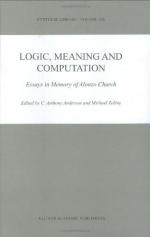|
This section contains 555 words (approx. 2 pages at 300 words per page) |

|
1903-1995
American Mathematician
Like his more famous pupil Alan Turing (1912-1954), Alonzo Church contributed significantly to the foundations of computer science. He is credited, along with Turing, with formulating a key principle concerning computer logic involving recursion, or the recurring repetition of a given operation. His other principal achievement was Church's theorem (1936), which maintains that there is no decision procedure—i.e., no fail-safe method for ensuring that one will always reach correct conclusions—in mathematics.
Born in Washington, D.C., on June 14, 1903, Church was the son of Samuel and Mildred Letterman Church. He studied at Princeton University, where in 1924 he received his B.A. in mathematics. On August 25, 1925, Church married Mary Julia Kuczinski, with whom he had three children: Alonzo, Mary Ann, and Mildred.
Church earned his doctorate at Princeton in 1927, after which he spent a year as a fellow at Harvard. He followed this...
|
This section contains 555 words (approx. 2 pages at 300 words per page) |

|


